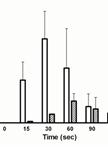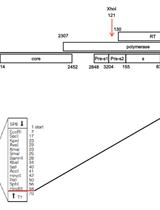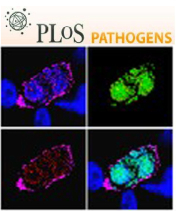- Submit a Protocol
- Receive Our Alerts
- Log in
- /
- Sign up
- My Bio Page
- Edit My Profile
- Change Password
- Log Out
- EN
- EN - English
- CN - 中文
- Protocols
- Articles and Issues
- For Authors
- About
- Become a Reviewer
- EN - English
- CN - 中文
- Home
- Protocols
- Articles and Issues
- For Authors
- About
- Become a Reviewer
Evolution of Escherichia coli to Macrophage Cell Line
Published: Vol 4, Iss 17, Sep 5, 2014 DOI: 10.21769/BioProtoc.1227 Views: 11200
Reviewed by: Fanglian HeKanika Gera

Protocol Collections
Comprehensive collections of detailed, peer-reviewed protocols focusing on specific topics
Related protocols

In vitro DNA Polymerization Activity Assay Using Cell-free Extracts
Anurag K. Sinha and Malay K. Ray
Aug 20, 2014 9218 Views

Introduction and Sequencing of Patient-isolated HBV RT Sequences into the HBV 1.2-mer Replicon
Sung Hyun Ahn [...] Kyun-Hwan Kim
Apr 20, 2015 9666 Views

Estimation of the Minimum Number of Replication Origins Per Chromosome in any Organism
Marcelo S. da Silva
Oct 20, 2020 4168 Views
Abstract
The genomes of species of Escherichia coli (E. coli) show an extraordinary amount of diversity, which include commensal strains and strains belonging to different pathovars. Many strains of E. coli, which can cause mild or severe pathologies in humans, have a commensal ancestor. Understanding the evolutionary changes that can lead to a transition from commensal to pathogen is an important task, which requires integration of different methodologies. One method is experimental evolution of bacteria, in controlled environments, that mimic some of the selective pressures, likely to be important during the transition to pathogenesis. The success of such a transition will depend, at least partially, on ability of E. coli to adapt to the presence of cells of the immune system. Here, we describe a protocol for performing experimental evolution of a commensal strain of E. coli, a derivative of the well studied K12, under the constant selective pressure imposed by cells of the innate immune system, specifically RAW 264.7 murine macrophage cell line.
Keywords: Experimental evolutionMaterials and Reagents
- RAW 264.7 murine macrophage cell line (MΦ) (Sigma-Aldrich, catalog number: 91062702 )
- E. coli strains, marked with constitutive expression of yellow (YFP) and cyan (CFP) fluorescent proteins (e. g. E. coli- MC4100, galK::CFP/YFP, AmpR StrepR)
- RPMI media1640 (Life Technologies, Gibco®, catalog number: 11875-093 )
- 2-mercaptoethanol solution (Life Technologies, InvitrogenTM, catalog number: 31350-010 )
- 1 M Hepes buffer (Life Technologies, InvitrogenTM, catalog number: 15630-056 )
- 100 mM sodium pyruvate (Life Technologies, InvitrogenTM, catalog number: 11360-039 )
- Heat-inactivated Fetal Bovine Serum (FBS) (Life Technologies, Gibco®, catalog number: 10500-064 )
- GlutaMAX (100X) (Life Technologies, Gibco®, catalog number: 35050-038 )
- 10,000 U/ml penicillin/streptomycin (Life Technologies, Gibco®, catalog number: 15140-122 )
- Streptomycin sulfate salt (Sigma-Aldrich, catalog number: S9137 )
- 50 mg/ml gentamycin solution (Sigma-Aldrich, catalog number: G1397 )
- 1x phosphate-buffered saline (PBS)
- Trypan Blue solution (Sigma-Aldrich, catalog number: T8154 )
- CpG-ODN -1826 (5´-TCCATGACGTTCCTGACGTT-3´) (Sigma-Aldrich)
- RPMI-complete media (see Recipes)
- RPMI-Strep media (see Recipes)
Equipment
- CO2 incubators
- Microscope
- Luria-Bertani (LB) agar plates (Panreac Life-sciences, catalog number: 596661.1210 )
- Centrifuge (Sigma-Aldrich, model: 4K15 with a rotor 11150 )
- Neubauer cell counting chamber (VWR International, catalog number: 631-1114 )
- Air flow chamber
- 12-well microtiter plates (Costar, catalog number: 3513 )
- Cell culture flasks (25 cm2 and 75 cm2 growth area) (Corning, catalog numbers: 430639 and 430641 )
- 15 ml Falcon tubes
- Cell scrapers (16 cm and 25 cm) (SARSTEDT AG, catalog numbers: 83.1832 and 83.1830 )
- 2 μm size beads (Sphero AccuCount Blank Particles) (Spherotech, catalog number: ACBP-20-10 )
- LSR Fortessa Flow cytometer
Procedure
- Grow MΦ in two 75 cm2 culture flasks (20 ml total volume) in RPMI- complete media until 80% (flask A) and 25% (flask B) confluency (Note 1).
Condition: The cell cultures are maintained in an incubator with 5% CO2 and 37 °C, including incubation steps.
Day 1
- Remove old media, add fresh media (same volume) and detach MΦ with a 25 cm cell scraper from the flask A.
- Carefully pipette culture up and down until pellet is dissolved.
- Leave 5 ml of the cell suspension in the flask A and add 15 ml of RPMI-complete media.
- Centrifuge remaining 15 ml of MΦ cell suspension in two 15 ml Falcon tubes at 1,200 rpm for 5 min (Note 2).
- Remove supernatant and re-suspend pellet in the same volume of RPMI-Strep media (7.5 ml for each falcon tube) (Note 3).
- Count MΦ in the Neubauer cell counter with Trypan blue viability dye (use 10 μl of cell suspension with 10 μl of dye) and use approximately 0.7-1.3 x 106 cells/ml for activation. Allow the dye to stain for approximately 5 to 15 min. If cells are exposed to extended period of time to this dye, viable cells, as well as nonviable cells, may begin to uptake dye.
- Transfer this amount of cells into a 25 cm2 flask (8 ml total volume) and activate them with CpG-ODN at a final concentration of 2 µg/µl for 24 h (Note 4).
- Grow E. coli - CFP (or YFP) bacterial population from the frozen stock in RPMI-Strep media in the 12-well plates (3 ml of the total volume for each well) for 24 h in the same conditions as the cell cultures (CO2 incubator at 37 °C and 5% CO2) (Note 5).
Day 2
- Repeat steps 2-8 with MΦ from the flask B.
- Repeat steps 2-3 with activated MΦ from flask A (use a 16 cm scraper).
- Centrifuge MΦ cell suspension in one 15 ml Falcon tube at 1,000 rpm for 5 min and resuspend using RPMI-Strep at the same volume.
- After counting the cells, seed activated MΦ at 0.8-1.6 x 106 cells/ml in 12-well microtiter plates (3 ml of total volume for each well).
- Allow cells to attach in the 37 °C, 5% CO2 incubator for 2 h.
- Count numbers of grown bacteria by using 2 μm size beads in the Flow cytometer (Note 6).
- Wash activated and attached MΦ with RPMI-Strep media (remove old and add new media, same volume).
- Infect activated MΦ at the multiplicity of infection (MOI) of 1 to 1 (106 bacteria/ml to 106 MΦ/ml).
Day 3
- Repeat steps 2-8 with MΦ from the flask A.
- Repeat steps 2-3 with activated MΦ from flask B (use a 16 cm scraper).
- Centrifuge MΦ cell suspension in one 15 ml falcon tube at 1,000 rpm for 5 min and resuspend using RPMI-Strep at the same volume.
- After counting the cells, seed activated MΦ at 0.8-1.6 x 106 cells/ml in 12-well microtiter plates (3 ml of total volume for each well) and allow cells to attach in the 37 °C 5% CO2 incubator for 2 h.
- After 24 h of infection (12-well infection plate from the Day 2), detach MΦ with a 16 cm cell scraper and centrifuge culture at 4,000 rpm for 10 min. This procedure lyses MΦ and releases intracellular bacteria (Note 7).
- Discard the supernatant and resuspend each pellet in 3 ml of PBS.
- Dilute bacteria in PBS, count their numbers in flow cytometer.
- Use this bacteria to infect activated MΦ again (from flask B) at the multiplicity of infection (MOI) of 1 to 1 (106 bacteria/ml to 106 MΦs/ml).
- Freeze a sample of the bacterial culture every day and keep your stocks (“fossil records”) at -80 °C.
- Repeat steps from Day 2 and Day 3 to continue with evolution experiment (Note 8).
Notes
- To be able to repeat the same protocol every day, maintain MΦ always in the two 75 cm2 culture flasks. Use MΦ from the flask A for every odd and the flask B for every even day of evolution experiment. To estimate confluency compare the amount of space covered by cells with unoccupied spaces (check: http://www.abcam.com/ps/pdf/protocols/cell_culture.pdf).
- If MΦ culture has many dead (aggregated or detached) cells centrifuge at 800 rpm, this way healthy cells will pellet at the bottom of the tube and dead cells will remain mainly in the supernatant.
- Streptomycin is used to enable the growth of STR resistant E. coli in the media and control for possible contaminations by other bacteria. If you use different antibiotic, test if antibiotic is not toxic for MΦ cell line.
- This dilution is necessary because MΦ will grow in 24 h. We use CpG-ODN-1826, because ODN 1826 is a B-class CpG ODN specific for mouse TLR9 that leads to strong immunostimulatory effects after 24 h of activation. If you intend to use other cell line (e.g. ODN 2395 is specific for class C human TLR9) choose an appropriate ODN. How to prepare a bacterial stock for evolution experiment:
- Streak a bacterial culture on LB plate and grow for 24 h at 37 °C.
- Isolate and inoculate a single bacterial colony into RPMI-Strep media.
- After 24 h of growth, freeze culture in glycerol solution [500 µl of bacterial culture with 500 µl of glycerol (30% stock solution)].
- Use this stock to start evolution experiment.
- Streak a bacterial culture on LB plate and grow for 24 h at 37 °C.
- You can use the following dilution to count in the flow cytometer: 10 µl of bacterial culture (diluted 1: 100), 10 µl of beads and 180 ml PBS.
- You can also detach MΦ, by bending a blue 1,000 µl pipette tip and using it as a scraper. Remember that for each replicate well you need to use a new sterile scraper.
- To perform phenotypic characterization of the evolved E. coli check our other protocol “Fitness Measurements of Evolved Esherichia coli” (Miskinyte and Gordo, 2014) and original paper (Miskinyte et al., 2013).
Recipes
- RPMI-complete media
500 ml RPMI 1640
50 ml FBS
5 ml sodium pyruvate
5 ml hepes
5 ml L-glutamax
0.5 ml 2-mercaptoethanol solution
0.5 ml gentamycin solution
5 ml penicillin/streptomycin solution
Stored at 4 °C
- RPMI-Strep media
500 ml RPMI 1640
50 ml FBS
5 ml sodium pyruvate
5 ml hepes
5 ml L-glutamax
0.5 ml 2-mercaptoethanol solution
1 ml of 50 mg/ml streptomycin solution
Stored at 4 °C
Acknowledgments
This protocol was adapted or modified from Lenski et al. (1991). The research received funding from the European Research Council under the European Community's Seventh Framework Programme (FP7/2007–2013)/ERC grant agreement no 260421 – ECOADAPT. IG acknowledges the salary support of LAO/ITQB & FCT.
References
- Lenski, R. E., Rose, M. R., Simpson, S. C. and Tadler, S. C. (1991). Long-term experimental evolution in Escherichia coil. I. Adaptation and divergence during 2,000 generations. American Naturalist 138:1315-1341.
- Miskinyte, M. and Gordo, I. (2014). Fitness measurements of evolved Esherichia coli. Bio-protocol 4(17): e1228.
- Miskinyte, M., Sousa, A., Ramiro, R. S., de Sousa, J. A., Kotlinowski, J., Caramalho, I., Magalhaes, S., Soares, M. P. and Gordo, I. (2013). The genetic basis of Escherichia coli pathoadaptation to macrophages. PLoS Pathog 9(12): e1003802.
Article Information
Copyright
© 2014 The Authors; exclusive licensee Bio-protocol LLC.
How to cite
Readers should cite both the Bio-protocol article and the original research article where this protocol was used:
- Miskinyte, M. and Gordo, I. (2014). Evolution of Escherichia coli to Macrophage Cell Line. Bio-protocol 4(17): e1227. DOI: 10.21769/BioProtoc.1227.
- Miskinyte, M., Sousa, A., Ramiro, R. S., de Sousa, J. A., Kotlinowski, J., Caramalho, I., Magalhaes, S., Soares, M. P. and Gordo, I. (2013). The genetic basis of Escherichia coli pathoadaptation to macrophages. PLoS Pathog 9(12): e1003802.
Category
Microbiology > Microbe-host interactions > Bacterium
Microbiology > Microbial genetics > DNA > DNA replication
Molecular Biology > DNA > Genotyping
Do you have any questions about this protocol?
Post your question to gather feedback from the community. We will also invite the authors of this article to respond.
Share
Bluesky
X
Copy link









